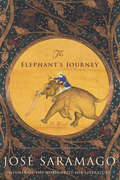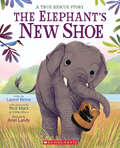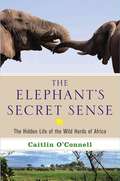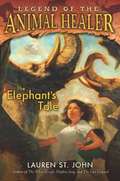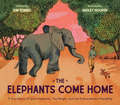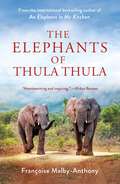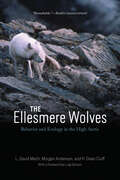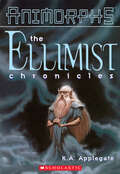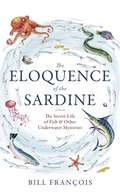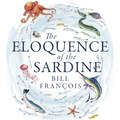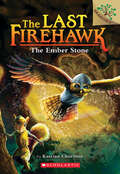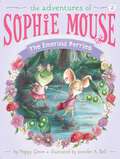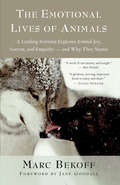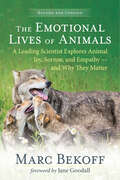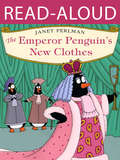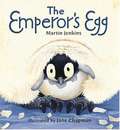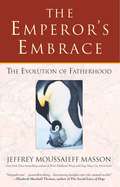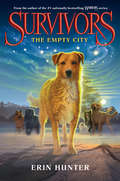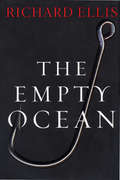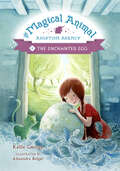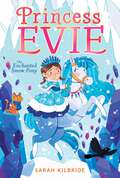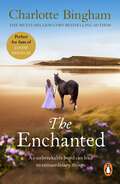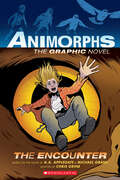- Table View
- List View
The Elephant's Journey: A Novel
by José Saramago&“The Portuguese Nobel Prize winner&’s delightful posthumous novel recounts the [16th century] travels of an Indian elephant…from Lisbon to Vienna&” (The New Yorker).In 1551, King João III of Portugal gave Archduke Maximilian an unusual wedding present: an elephant named Solomon. In The Elephant&’s Journey, José Saramago imagines Solomon&’s epic journey by foot across Europe with his Hindu keeper Subhro along for the adventure.Accompanied by the Archduke, his new wife, and the royal guard, these unlikely heroes traverse a continent riven by the Reformation and civil wars. They are witnessed by scholars, historians, and wide-eyed ordinary people as they make their way through the storied cities of northern Italy, brave the Alps, cross the Mediterranean Sea, and at last, make their way toward their grand entry into the imperial city.&“A tale rich in irony and empathy, regularly interrupted by witty reflections on human nature and arch commentary on the powerful who insult human dignity.&”—Los Angeles Times
The Elephant's New Shoe
by Laurel NemeThis sweet true story stars a tiny, orphaned elephant who was given another chance.When Chhouk, an Asian elephant calf, was found, he was alone, underweight, and had a severe foot injury. Conservationist Nick Marx of Wildlife Alliance rescued the baby elephant. With help from the Cambodian Forestry Administration, the Cambodian School of Prosthetics and Orthotics, and an elephant named Lucky, Nick nursed Chhouk back to health and made him an artificial foot. One of the first animals to ever be fitted with a prosthetic, Chhouk helped pioneer the technology -- and most importantly, was able to walk again!This true animal rescue story will satisfy animal lovers and capture the hearts of both young readers and their parents.
The Elephant's Secret Sense
by Caitlin O'ConnellWhile observing a family group of elephants in the wild, Caitlin O'Connell, a young field scientist, noticed a peculiar listening behavior. A matriarch she had been watching for months turned her massive head and lifted her foot off the ground. As she scanned the horizon, the other elephants followed suit, all facing the same direction. O'Connell soon made a groundbreaking discovery: the elephants were "listening through limbs," feeling the ripples of the earth's surface for approaching friends and enemies. Through their feet, toenails, trunks, and other, subtler modes of communication, these enormous animals were communicating to one another, demonstrating the vital importance of social relationships in their lives. Yet this grand revelation about the intelligence of wild animals is also a story of the relationship between humans and elephants as neighbors, vying for the same resources of an increasingly crowded continent. For when O'Connell was first contracted by the Namibian government to develop new methods to deter elephants from raiding villagers' crops, she was unprepared for what she would encounter -- political upheaval, tribal disputes, inhumane poachers, and a fundamentally ineffective approach to wildlife conservation. Despite these setbacks, she came to know and love each of the fascinating, unique elephants under her watchful eye, while at the same time witnessing a change in attitude and policy, providing hope for the elephant's future. An unforgettable journey of scientific discovery, The Elephant's Secret Sense takes you deep into the wilds of Namibia, from the tops of isolated, desert observation towers to the jaws and claws of ravenous lions to aerial expeditions and dusty highways, where the naturalists do their difficult work in a troubled land threatened by expanding human populations and unstable politics. Resonant with the powerful calls of the mysterious elephant, this is a story about the resilience of nature and the inspiring, astonishing, and often heartbreaking places where humans and wild animals come together.
The Elephant's Tale (The\white Giraffe Ser. #4)
by St. John LaurenIt's the first day of the December school holidays and Martine has lots of fun planned for the next few weeks, not least spending time with Jemmy, her beloved white giraffe, and her best friend, Ben. But her plans for a peaceful holiday are soon shattered when a sinister man informs Martine and her grandmother that Sabuwona is about to be repossessed. The nature reserve, and everything in it, will no longer belong to them. Martine is determined to save the home she's grown to love. When Grace has a vision about a unique herd of Namibian elephants, she knows she must travel to Namibia to learn their secrets. This could be the answer to all their troubles . . . The fourth thrilling African adventure, written with all the zest and skill that has endeared so many readers to THE WHITE GIRAFFE, DOLPHIN SONG and THE LAST LEOPARD.
The Elephants Come Home: A True Story of Seven Elephants, Two People, and One Extraordinary Friendship
by Kim TomsicThe amazing true story of a herd of elephants, the man who saved them, and the miracle of love that brought them home.One day in 1999, Lawrence Anthony and Françoise Malby hear that a herd of wild African elephants need a new home. They welcome the elephants to their wildlife sanctuary—Thula Thula—with open arms. But the elephants are much less sure they want to stay. How will Lawrence prove to them that they are safe and loved? What follows is a gorgeously illustrated real-life story of a friendship . . . and the story of the miraculous way that love given freely will return—greater and more wonderful than it began.• TOUCHING ANIMAL FRIENDSHIPS: Owen and Mzee, Tarra and Bella, Rescue and Jessica . . . touching true stories of the emotional bonds possible between species are charming, and speak to the limitlessness of love.• ELEPHANT APPEAL: Elephants are one of the most fascinating and charming wild animals in all of nature. This heartwarming true story will intrigue and inspire children, and turn even the most reluctant readers into elephant enthusiasts.• CONSERVATION THEME: This book tells the true story of caring for one of the world's most beloved endangered animals: the African elephant. This book is a great, upbeat jumping-off point for discussions of the importance of preserving endangered species and their environments.• ENGAGING NONFICTION: There's no better way to get readers hooked on factual books than to offer them real-life stories with heart and meaning.• STRONG CURRICULUM CONNECTIONS: The Next Generation Science Standards (NGSS) emphasize learning about animal habitats/biomes in K–2 curriculums, while later grades address topics like conservation and endangered species. With a depth of research and an engaging, highly visual narrative, this book is an excellent resource for librarians and primary school educators.Perfect for:• Kindergarten and elementary school teachers• Parents and grandparents• Librarians• Lovers of animals, wildlife, and the natural world• Zoo and natural history museumgoers
The Elephants of Thula Thula (Elephant Whisperer #3)
by Françoise Malby-AnthonyFrançoise Malby-Anthony's The Elephants of Thula Thula is a powerful, gripping story about an extraordinary herd of elephants and the woman dedicated to keeping them safe.‘Somehow, the elephants got into my soul, and it became my life’s work to see them safe and happy. There was no giving up on that vision, no matter how hard the road was at times.’Françoise Malby-Anthony is the owner of a game reserve in South Africa with a remarkable family of elephants whose adventures have touched hearts around the world. The herd’s feisty matriarch Frankie knows who’s in charge at Thula Thula, and it’s not Francoise. But when Frankie becomes ill, and the authorities threaten to remove or cull some of the herd if the reserve doesn’t expand, Françoise is in a race against time to save her beloved elephants . . .The joys and challenges of a life dedicated to conservation are vividly described in The Elephants of Thula Thula. The search is on to get a girlfriend for orphaned rhino Thabo – and then, as his behaviour becomes increasingly boisterous, a big brother to teach him manners. Françoise realizes a dream with the arrival of Savannah the cheetah – an endangered species not seen in the area since the 1940s – and finds herself rescuing meerkats kept as pets. But will Thula Thula survive the pandemic, an invasion from poachers and the threat from a mining company wanting access to its land?As Françoise faces her toughest years yet, she realizes once again that with their wisdom, resilience and communal bonds, the elephants have much to teach us.
The Ellesmere Wolves: Behavior and Ecology in the High Arctic
by L. David Mech Morgan Anderson H. Dean CluffIn a fascinating story of discovery and science, we meet a remote population of wolves unafraid of humans. For parts of twenty-four summers, wolf biologist L. David Mech lived with a group of wolves on Ellesmere Island, some six hundred miles from the North Pole. Elsewhere, most wolves flee from even the scent of humans, but these animals, evolving relatively free from human persecution, are unafraid. Having already spent twenty-eight years studying other populations of wolves more remotely by aircraft, snow-tracking, live-trapping, and radio-tracking, Mech was primed to join their activities up close and record their interactions with each other. This book tells the remarkable story of what Mech—and the researchers who followed him—have learned while living among the wolves. The Ellesmere wolves were so unconcerned with Mech’s presence that they allowed him to camp near their den and to sit on his all-terrain vehicle as he observed them, watching packs as large as seven adults and six pups go about their normal activities. In these extraordinarily close quarters, a pup untying his bootlace or an adult sniffing his gloved hand was just part of daily life. Mech accompanied the wolves on their travels and watched as they hunted muskoxen and arctic hares. By achieving the same kind of intimacy with his wild hosts’ every action that we might experience living with domesticated dogs, Mech gained new insights into common but rarely studied behaviors like pup feeding, food caching, howling, and scent-marking. After Mech’s time at Ellesmere ended, his coauthors and fellow wolf researchers Morgan Anderson and H. Dean Cluff spent parts of four summers studying the wolves via radio collars, further illuminating the creatures’ movements and ecology. This book synthesizes their findings, offering both a compelling scientific overview of the animals’ behavior—from hunting to living in packs to rearing pups—and a tale of adventure and survival in the Arctic.
The Ellimist Chronicles (Animorphs)
by K. A. ApplegateHe is called the Ellimist. A being with the ability to alter space and time. A being with a power that will never be fully understood. He is the reason Elfangor came to Earth. He is the reason the Earth now has a fighting chance. And though his actions never seem quite right or wrong, you can be certain they are never, ever what anyone expects.This is the beginning and the middle of the story. A story that needs to be told in order to understand what might happen to the future. The future of the Animorphs. The future of humanity. The future of Earth.He is called the Ellimist. And this is his story...
The Eloquence of the Sardine: The Secret Life of Fish & Other Underwater Mysteries
by Bill FrancoisHumans have identified just a fraction of the 2.2 million species living in the sea. Roughly 91% of all marine species remain unknown: myths still to be written, discoveries still to be made, blank pages with room to dream . . .As a small boy, Bill François was frightened of deep water. Until a chance encounter with the elusive sardine set him on course for a life in marine science: a mission to better understand, and preserve, the underwater world, to find his place in that ecosystem and learn how to converse harmoniously with the ocean.In a series of exquisitely rendered vignettes of marine life, François invites us on a whistle-stop global tour to reveal the mysteries of the sea, beginning with the simple eloquence of the sardine. He unpicks the sound of the sea - an underwater symphony orchestra voiced by a choir of fish - and deciphers the latest scientific discoveries on the immunity of coral and the changing gender of wrasses. We visit the depths of underwater Paris as François delves into the mysterious world of the eel and explore an extraordinary three-generational friendship between humans and killer whales, and the role a shoal of herrings played in Cold War tensions.Throughout, François effortlessly brings the inner workings of fish to life - their language, their emotions, their societal rituals. He also makes a case for why we should look to the sea for inspiration for improving society and investigates the shocking journey from sea to plate.Drawing on history, myth and legend, but always grounded in science, The Eloquence of the Sardine will change the way you think about the sea in the most poetic of ways.
The Eloquence of the Sardine: The Secret Life of Fish & Other Underwater Mysteries
by Bill FrancoisHumans have identified just a fraction of the 2.2 million species living in the sea. Roughly 91% of all marine species remain unknown: myths still to be written, discoveries still to be made, blank pages with room to dream . . .As a small boy, Bill François was frightened of deep water. Until a chance encounter with the elusive sardine set him on course for a life in marine science: a mission to better understand, and preserve, the underwater world, to find his place in that ecosystem and learn how to converse harmoniously with the ocean.In a series of exquisitely rendered vignettes of marine life, François invites us on a whistle-stop global tour to reveal the mysteries of the sea, beginning with the simple eloquence of the sardine. He unpicks the sound of the sea - an underwater symphony orchestra voiced by a choir of fish - and deciphers the latest scientific discoveries on the immunity of coral and the changing gender of wrasses. We visit the depths of underwater Paris as François delves into the mysterious world of the eel and explore an extraordinary three-generational friendship between humans and killer whales, and the role a shoal of herrings played in Cold War tensions.Throughout, François effortlessly brings the inner workings of fish to life - their language, their emotions, their societal rituals. He also makes a case for why we should look to the sea for inspiration for improving society and investigates the shocking journey from sea to plate.Drawing on history, myth and legend, but always grounded in science, The Eloquence of the Sardine will change the way you think about the sea in the most poetic of ways.
The Ember Stone: A Branches Book (The Last Firehawk #1)
by Katrina CharmanMagic, fantasy, and adventure combine to create a grippingly fast-paced new series for young readers -- The Last Firehawk!Pick a book. Grow a Reader!This series is part of Scholastic's early chapter book line Branches, aimed at newly independent readers. With easy-to-read text, high-interest content, fast-paced plots, and illustrations on every page, these books will boost reading confidence and stamina. Branches books help readers grow!A terrible darkness is spreading across Perodia. Thorn, a powerful vulture, is using dark magic (and his dark army of spies!) to destroy the magical land. A young owl named Tag may be the only one who can save it! Tag dreams of one day becoming a brave warrior, but he is small . . . In this first book, Tag and his best friend -- a squirrel named Skyla -- meet the last firehawk. Together, the three friends learn about a magical stone. Could this stone be powerful enough to defeat Thorn? This action-packed series makes a great introduction to fantasy and quest stories for newly independent younger readers. Realistic black-and-white artwork appears on every page!
The Emerald Berries (The Adventures of Sophie Mouse #2)
by Poppy GreenIn this second book of The Adventures of Sophie Mouse, Sophie and her friend Hattie Frog go on a daring adventure through the woods in search of some special art supplies!In the second book in The Adventures of Sophie Mouse, Sophie learns about some special emerald berries that will make the most perfect color for a painting she wants to do! But the seamstress who’s using the berries tells Sophie that they can only be found in one part of the forest: Weedsnag Way. Though that’s far from home, and a little scary, Sophie convinces her best friend, Hattie Frog, that they will be fine. But all is not quite fine, and the girls get lost along the way! Thanks to the help of a squirrel who disappeared from Pine Needle Grove years ago, Sophie and Hattie find the emerald berries…and their way home! With easy-to-read language and illustrations on almost every page, the Adventures of Sophie Mouse chapter books are perfect for beginning readers.
The Emotional Lives of Animals
by Marc BekoffBased on award-winning scientist Marc Bekoff's years studying social communication in a wide range of species, this important book shows that animals have rich emotional lives. Bekoff skillfully blends extraordinary stories of animal joy, empathy, grief, embarrassment, anger, and love with the latest scientific research confirming the existence of emotions that common sense and experience have long implied. Filled with Bekoff's light humor and touching stories, The Emotional Lives of Animals is a clarion call for reassessing both how we view animals and how we treat them.
The Emotional Lives of Animals (revised): A Leading Scientist Explores Animal Joy, Sorrow, and Empathy — and Why They Matter
by Marc BekoffA seminal exploration of animal emotion, sentience, and cognition, revised and expanded to incorporate a surge of new science When award-winning scientist Marc Bekoff penned the first edition of this book in 2007, he predicted that over time our understanding of animal cognition and emotion would grow “richer, more accurate, and possibly different.” Since then, not only has the field seen an explosion of new and startling research, but the popular interest in the subject has grown as well, spawning countless podcasts, articles, and bestselling books. Bekoff skillfully blends extraordinary stories of animal joy, empathy, grief, embarrassment, anger, and love with the latest scientific research confirming the existence of emotions that common sense and experience have long implied. Filled with light humor and compassion, The Emotional Lives of Animals is a clarion call for reassessing both how we view and how we treat animals.
The Emotional Lives of Animals and Children
by William CrainIn 2008, Bill Crain, a professor of psychology at The City College of New York, and his wife Ellen, a pediatrician, opened Safe Haven Farm Sanctuary in Poughquag, New York. The sanctuary provides a permanent home to over 70 animals rescued from slaughter and abusive situations, including goats, sheep, chickens, turkeys, ducks, partridges, and a mini-horse. It also has afforded Bill a tremendous opportunity to observe animals in all manner of emotional states and how their behavior casts light on the emotions of human children. In The Emotional Lives of Animals and Children, Crain honors the work of John Bowlby a psychoanalyst who began his major writings in the 1950s. Bowlby drew on biologists' observations of animals to provide a compelling account of children's attachment to their caretakers. "Today, the study of attachment is extremely popular," Crain writes, but "one would hardly know that the initial inspiration came from observations of non-human animals. Moreover, there has been little effort to extend Bowlby's work - to see how the study of animals illuminates other aspects of child development. " Crain suggests that the reluctance to follow Bowlby's lead reflects the Western worldview that considers humans as different from and superior to other species. To think about children in the same category as animals seems to demean children. But Crain discovered that the farm animals' emotional behaviors can help us understand those of human children. The Emotional Lives of Animals and Children is divided into two parts. Part one discusses six emotional behaviors that are shared by animals and children: fear, play, freedom, care, spirituality, and resilience. Part two addresses the broader social theme of our Western culture's disparagement of animals. Initially, children do not set themselves apart from nature, but experience it with an instinctive empathy. However, they are eventually taught by our society to detach themselves and to devalue animals. Crain writes, "As people attempt to move beyond society's dominant views of animals, they can also draw on a neglected idea that goes back to ancient times. This is the view that there is a special wisdom in the child's ways of knowing. This view is found in the ancient Chinese Taoist statement, 'wise souls are children. '" About Safe Haven Farm Sanctuary Safe Haven Farm Sanctuary is located in Poughquag, New York, about an hour and a half outside of New York City. Its focus is on the rescue of abused and neglected farm animals. In doing so, it hopes to raise awareness of the plight of animals raised for food and the benefits of a vegan diet for animals, human health, and the environment. Wherever possible, the sanctuary tries to implement environmentally sound practices such as solar heating and the use of reclaimed wood.
The Emperor Penguin's New Clothes
by Janet PerlmanRead along edition featuring the voice of Bob Olivier. This much-loved Hans Christian Andersen classic is repopulated with a cast of penguins, and the Emperor is the best dressed of them all. When two scoundrels convince him that they can make him a suit of magic cloth, it’s not just the Emperor’s vanity that is showing when he wears it in the grand parade for all to see! Recommended reading ages 4 - 8
The Emperor's Egg
by Martin JenkinsThis introduction to the Emperor penguin of Antarctica furnishes factual information as we follow one father penguin's two-month stint on the ice, keeping his egg warm on his feet "tucked right up under" his tummy. In simple language, with humor and much empathy for the dad, the text rambles across the pages, using oversize type for emphasis, and telling an engrossing tale of endurance. In smaller italics, basic facts are added. The hatching of the chick and reappearance of the mother allow the hungry father to eat at last. It's about time, too! Chapman's naturalistic paintings zoom in on such details as the tucked-in egg, and sometimes expand to depict the vast blue-white nothingness of the landscape. The visual story is told with considerable clarity and enough variety to entice the reader to turn the page. The penguin on the jacket/cover is very appealing. An index is included. Library Journal
The Emperor’s Embrace: Reflections on Animal Families and Fatherhood
by Jeffrey Moussaieff MassonJeffrey Moussaieff Masson's "marvelous" (Jane Goodall) New York Times bestseller, When Elephants Weep, made us re-evaluate the emotional lives of animals. And in his follow-up New York Times bestseller, Dogs Never Lie About Love, Masson reflected with "intelligence and originality" (Los Angeles Times Sunday Book Review) on the emotional world of dogs. Now, in The Emperor's Embrace, Masson offers a remarkable look at one of the most fulfilling roles in the animal world: fatherhood. With fascinating insight, impeccable research, and captivating writing, controversial psychoanalyst Jeffrey Masson, a new father himself, introduces us to the world's best dads. He takes us to such places as Antarctica, as he explores how emperor penguin fathers incubate the eggs of their young by carrying them around on their feet for two months, nestled beneath a special brood pouch. And he tells us how, once the babies hatch, the fathers snuggle the babies on their feet until the mother returns from her time at sea, feeding them a special milk-like substance until her arrival. Masson, a superb storyteller, showcases the extraordinary behavior of outstanding fathers, heroes among animals, including:the wolf -- and why wolves make good fathers and dogs don't the beaver, who encourages his young to cling to his tail as he navigates through ponds the sea horse, the only male animal that gives birth to its young the marmoset, the South American monkey who carries his babies for the first two years of their lives wherever he goes. Masson also examines nature's worst fathers: lions, langurs, bears -- and humans. He shows that when a father does care for his young, as with the beaver, we immediately look for a biological and not an emotional explanation. But Masson demonstrates that for these animals, as with humans, fatherhood is a profound, all-encompassing experience. Groundbreaking, compelling, inspirational, Masson's unique look at one of nature's most venerable institutions takes us to animal habitats around the world, yet always returns to the heart. For animal lovers, fathers, mothers, sons, and daughters everywhere, The Emperor's Embrace is a book that will forever change our perceptions of parenthood and family love.
The Empire and the Five Kings: America's Abdication and the Fate of the World
by Bernard-Henri LévyOne of the West’s leading intellectuals offers a provocative look at America’s withdrawal from world leadership and the rising powers who seek to fill the vacuum left behind.The United States was once the hope of the world, a beacon of freedom and the defender of liberal democracy. Nations and peoples on all continents looked to America to stand up for the values that created the Western worldand to oppose autocracy and repression. Even when America did not live up to its ideals, it still recognized their importance, at home and abroad.But as Bernard-Henri Lévy lays bare in this powerful and disturbing analysis of the world today, America is retreating from its traditional leadership role, and in its place have come five ambitious powers, former empires eager to assert their primacy and influence. Lévy shows how these five—Russia, China, Turkey, Iran, and Sunni radical Islamism—are taking steps to undermine the liberal values that have been a hallmark of Western civilization.The Empire and the Five Kings is a cri de coeur that draws upon lessons from history and the eternal touchstones of human culture to reveal the stakes facing the West as America retreats from its leadership role, a process that did not begin with Donald Trump's presidency and is not likely to end with him. The crisis is one whose roots can be found as far back as antiquity and whose resolution will require the West to find a new way forward if its principles and values are to survive.As seen on Real Time with Bill Maher (2/22/2019) and Fareed Zakaria GPS (2/17/2019).
The Empty City (Survivors #1)
by Erin HunterLucky is a golden-haired mutt with a nose for survival. He has always been a Lone Dog, relying on his instincts to get by. Other dogs have Packs, but Lucky stands alone. Then the Big Growl strikes. Suddenly, the ground is split wide open. The Trap House is destroyed. And all the longpaws have disappeared. Now Lucky is trapped in a strange and desolate new world with no food, foul water, and enemies at every turn. He falls in with others left behind, including his littermate Bella, a Leashed Dog. Relying on other dogs—and having them depend on him—brings new dangers that Lucky isn't prepared for, but he may not be able to survive on his own. Can Lucky ever be a true Pack Dog?
The Empty Ocean: Plundering The World's Marine Life
by Richard EllisIn The Empty Ocean, acclaimed author and artist Richard Ellis tells the story of our continued plunder of life in the sea and weighs the chances for its recovery. Through fascinating portraits of a wide array of creatures, he introduces us to the many forms of sea life that humans have fished, hunted, and collected over the centuries, from charismatic whales and dolphins to the lowly menhaden, from sea turtles to cod, tuna, and coral. Rich in history, anecdote, and surprising fact, Richard Ellis's descriptions bring to life the natural history of the various species, the threats they face, and the losses they have suffered. Killing has occurred on a truly stunning scale, with extinction all too often the result, leaving a once-teeming ocean greatly depleted. But the author also finds instances of hope and resilience, of species that have begun to make remarkable comebacks when given the opportunity. Written with passion and grace, and illustrated with Richard Ellis's own drawings, The Empty Ocean brings to a wide audience a compelling view of the damage we have caused to life in the sea and what we can do about it. "
The Enchanted Egg (The Magical Animal Adoption Agency #2)
by Kallie GeorgeBook 2 in the marvelous illustrated chapter book series, The Magical Animal Adoption Agency.There's a new resident at the Magical Animal Adoption Agency-but this one hasn't hatched yet! Mr. Jams brought home an enchanted egg from his last journey, and Clover can't wait to find out what kind of creature the polka-dotted shell contains.But one morning when Clover checks on the cozy nest of feathers she's made for the egg, she finds it empty, and the baby animal is nowhere in sight! Clover is anxious to find the creature, but the Agency is full of visitors looking for pets of their own. Will Clover be able to match them with their perfect companions and save the mysterious animal before Mr. Jams returns from his trip?With charming illustrations by Alexandra Boiger, the second book in Kallie George's The Magical Animal Adoption Agency series celebrates the magic of new friends and the power of seeing with your heart.Praise for Clover's Luck"[This] gentle tale of magic and self-reliance will entertain confident new independent readers. Clover's sweet story is a good next step for lovers of the Magic Tree House." -- Kirkus Reviews"The first novel in George's new series is a charming story, delicately written, with a winning heroine. Clover's first adventure with the magical animals at the agency comes to a conclusion that will satisfy young readers." -- Booklist Online
The Enchanted Snow Pony (Princess Evie #4)
by Sarah KilBridePrincess Evie and her pony meet a fairy and go to a ball in this fourth book in the enchanting chapter book series about a princess, her stable full of ponies, and the amazing adventures they share.Join Evie and Silver on a wintry adventure to see the Northern Lights at the Mid-Winter Ball. There&’s so much to do before the Ball—sledding, making magical snow dresses, and catching up with old friends. Can Evie and her friends make it to the Ball and rescue one of the Queen&’s fairies on their way?
The Enchanted: a wonderfully uplifting story of a special friendship that runs incredibly deep from bestselling author Charlotte Bingham
by Charlotte BinghamExciting and dramatic but tender and heartfelt; this is a novel that you will return to again and again. From the million copy and Sunday Times bestselling author Charlotte Bingham, for fans of Louise Douglas and Dinah Jeffries.'A galloping read...Bingham relishes her period detail and social comedy and adds a touch of whimsy' -- SUNDAY TIMES'Mesmerising' -- ***** Reader review'I was hooked from beginning to end' -- ***** Reader review'Held me enthralled' -- ***** Reader review'LOVED IT, LOVED IT, LOVED IT!' -- ***** Reader review*************************************************************************************************AN UNBREAKBLE BOND CAN LEAD TO EXTRAORDINARY THINGSWhen Kathleen finds a mare in foal, she and her father take him in, despite the fact that they can barely afford to feed her. Tragically the mare dies, leaving an orphan that they name The Enchanted. As the young horse grows up among Ireland's lush pastures, Kathleen loses her heart to him...But as Kathleen has always feared The Enchanted must be sold. Rory James and his father take a chance on the little horse in the hope of improving the fortune of their run-down racing yard. But luck does not run Rory's way when The Enchanted mysteriously sickens. It seems that only Kathleen can help.And it is only under her care that The Enchanted is able to live up to his name and astonishing things start to happen to all those around him.
The Encounter (Animorphs Graphix #3)
by K. A. Applegate Michael GrantThe wildly popular, bestselling sci-fi series by Katherine Applegate and Michael Grant returns in a new full-color graphic novel series, adapted by Chris Grine.When Tobias and his friends were given the power to morph, they were also given an important warning: Never stay in a morph for more than two hours. But Tobias broke the time limit, and now he's trapped in the body of a hawk -- forever.When he discovers an important Yeerk secret, Tobias knows he has to do everything in his power to destroy it. But to do so, he'll have to contend with a part of himself that's wrestling for dominion. A part that isn't human.For Tobias, the fight against the Yeerks is more pressing than ever -- not just for humankind, but for his own humanity.
